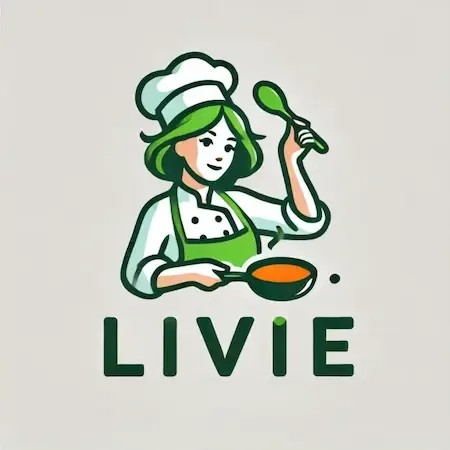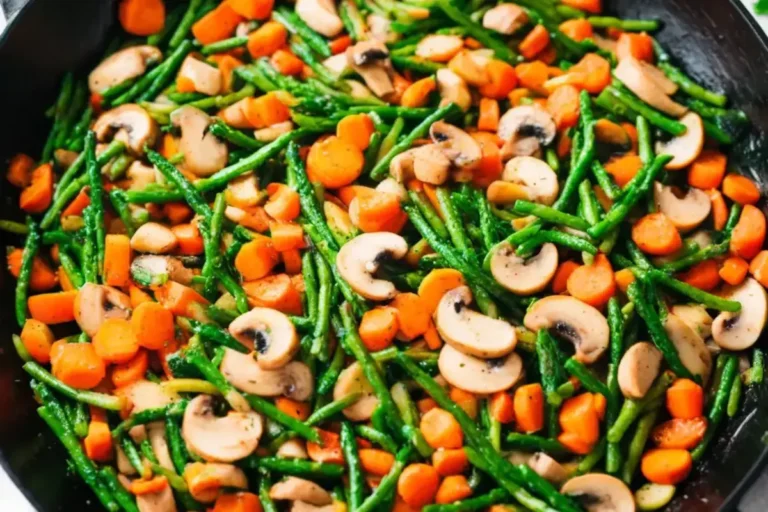Mastering the Art of Sautéing Vegetables – A Comprehensive Guide
Sautéing vegetables is an essential skill that every home cook should master. This cooking technique not only brings out the natural flavors of vegetables but also retains their nutrients, color, and texture. Whether you’re preparing a quick weeknight meal or enhancing a more complex dish, knowing how to sauté vegetables properly can elevate your culinary creations to the next level.
In this comprehensive guide, we’ll walk you through everything you need to know about sautéing vegetables. For those interested in adding these sautéed veggies to a more elaborate dish, you can check out our chicken parmigiana recipe, where the perfectly cooked vegetables complement the rich tomato sauce and tender chicken.
Moreover, the health benefits of incorporating more vegetables into your diet are undeniable. If you’re looking to learn more about the nutritional advantages, consider exploring our article on delicious and healthy cottage cheese recipes, which also highlights creative ways to enjoy nutrient-rich foods.
Essential Ingredients for Sautéing Vegetables
To achieve the best results when sautéing vegetables, you’ll need the following ingredients:
- Vegetables: Choose a variety of vegetables like bell peppers, onions, zucchini, mushrooms, and spinach. Ensure they are fresh and cut into uniform pieces for even cooking.
- Oil: Use a high smoke point oil like olive oil, avocado oil, or grapeseed oil. These oils are ideal for high-heat cooking and add a subtle flavor to the vegetables.
- Seasonings: Common seasonings include salt, pepper, garlic, and herbs like thyme or oregano. Feel free to add spices such as paprika or cumin for extra flavor.
- Optional Add-ins: Butter, soy sauce, or balsamic vinegar can be added at the end for additional richness and depth.
Kitchen Tools
- Skillet or Sauté Pan: A wide, heavy-bottomed skillet or sauté pan is ideal for this technique. It allows for even heat distribution and enough space to prevent overcrowding.
- Spatula: Use a spatula to stir the vegetables frequently, ensuring even cooking.
- Knife: A sharp knife is essential for cutting vegetables into uniform pieces.
Step-by-Step Guide to Sautéing Vegetables
1. Preparing the Vegetables
Start by washing and drying the vegetables thoroughly. Cut them into uniform pieces to ensure they cook evenly. For instance, bell peppers and onions should be sliced into thin strips, while zucchini and mushrooms can be cut into bite-sized pieces.
2. Heating the Oil
Place your skillet or sauté pan over medium-high heat. Once the pan is hot, add a tablespoon of oil, swirling it around to coat the bottom evenly. The oil should shimmer but not smoke, indicating it’s ready for cooking.
3. Adding the Vegetables
Add the vegetables to the pan in a single layer, avoiding overcrowding. If you’re cooking a large batch, it’s best to sauté the vegetables in batches to ensure they brown rather than steam. For example, start with denser vegetables like carrots and bell peppers, then add softer ones like spinach or mushrooms toward the end.
4. Sautéing the Vegetables
Stir the vegetables frequently with a spatula to ensure even cooking. However, be careful not to stir too often, as this can prevent browning. The vegetables should be tender but still retain some of their bite. Depending on the type of vegetables, sautéing can take anywhere from 5 to 10 minutes.
For a more in-depth understanding of achieving the perfect texture, you might want to explore our guide on air fryer bacon-wrapped chicken, which offers tips on balancing tenderness and crispiness.
5. Seasoning and Finishing Touches
Season the vegetables with salt, pepper, and any herbs or spices you like. At this stage, you can also add a knob of butter or a splash of soy sauce for extra flavor. If you’re looking to add a sweet and tangy note, consider drizzling some balsamic vinegar over the vegetables just before removing them from the heat.
6. Serving the Vegetables
Serve the sautéed vegetables immediately as a side dish, or incorporate them into other dishes like pasta, rice bowls, or vegetarian quesadillas.
Tips for Perfectly Sautéed Vegetables
To achieve the best results, keep these tips in mind:
- Avoid Overcrowding the Pan: Overcrowding the pan causes the vegetables to steam instead of sauté, resulting in a soggy texture. For larger batches, sauté in stages or use two pans.
- Choose the Right Oil: Use oils with a high smoke point, such as avocado or grapeseed oil. This choice helps prevent the oil from burning and imparting a bitter flavor.
- Season Towards the End: Adding salt too early can draw moisture out of the vegetables, leading to steaming. Instead, season them toward the end of the cooking process.
For more kitchen tips and tricks, check out our guide on crispy fried chicken, which offers insights into achieving the perfect crunch and flavor.
Sautéing Vegetables – Variations and Uses
Sautéed vegetables are incredibly versatile and can be used in a variety of dishes. Here are some ideas:
1. Sautéed Vegetable Stir-Fry
- Combine your sautéed vegetables with cooked rice or noodles, and add a protein like tofu or chicken for a quick and nutritious stir-fry.
2. Sautéed Vegetables in Pasta
- Toss your sautéed vegetables with cooked pasta, olive oil, and Parmesan cheese for a simple yet satisfying meal. For a creamy twist, try adding a dollop of our vanilla buttercream frosting to the sauce (it’s unconventional but adds a surprising depth!).
3. Sautéed Vegetables in Quesadillas
- Use your sautéed vegetables as a filling for vegetarian quesadillas, along with cheese and beans for a delicious, meatless option.
4. Sautéed Vegetables on Pizza
- Add your sautéed vegetables to pizza, along with your favorite toppings, for a homemade pizza that’s bursting with flavor.
5. Sautéed Vegetables in Omelets
- Mix your sautéed vegetables into an omelet for a hearty and healthy breakfast.
Storage and Reheating Tips
Sautéed vegetables store well and can be easily reheated, making them a great option for meal prep:
Refrigeration
Store leftover sautéed vegetables in an airtight container in the refrigerator for up to 3 days.
Freezing
You can freeze sautéed vegetables, although some vegetables may lose their texture after thawing. To freeze, spread the vegetables out on a baking sheet in a single layer and freeze until solid, then transfer to a freezer-safe bag or container.
Reheating Instructions
Reheat sautéed vegetables in a skillet over medium heat until warmed through. Avoid microwaving, as this can make the vegetables soggy.
Nutritional Information
Sautéed vegetables are not only delicious but also packed with nutrients. Here’s a general overview:
- Calories: Sautéed vegetables are low in calories, typically ranging from 50 to 150 calories per serving, depending on the oil and vegetables used.
- Fat: The fat content primarily comes from the oil used in sautéing. Opt for heart-healthy oils like olive or avocado oil to add beneficial fats.
- Carbohydrates: Vegetables are naturally low in carbs, making them suitable for low-carb and keto diets.
- Fiber: Vegetables are a great source of dietary fiber, aiding in digestion and helping you feel full longer.
Healthy Adjustments
- Use minimal oil to reduce the fat content without compromising flavor.
- Add a variety of vegetables to increase the fiber and nutrient density of your dish.
For more healthy and delicious recipes, explore our high-protein toasted cottage cheese recipes, which offer a variety of nutritious options.
Frequently Asked Questions
Can I sauté frozen vegetables?
Yes, you can sauté frozen vegetables, but it’s best to thaw them first and pat them dry to remove excess moisture. This step helps prevent them from becoming soggy.
What’s the difference between sautéing and stir-frying?
Sautéing uses medium-high heat and a small amount of fat, while stir-frying typically involves higher heat and constant stirring with more oil. Both methods aim to cook food quickly, but stir-frying is often used for Asian cuisine.
Can I use butter instead of oil for sautéing?
Yes, butter adds a rich flavor to sautéed vegetables. However, it has a lower smoke point than oil, so it’s best to use a combination of butter and oil to prevent burning.
What are the best vegetables to sauté?
Almost any vegetable can be sautéed, but some of the best include bell peppers, onions, zucchini, mushrooms, and spinach. Root vegetables like carrots can also be sautéed but may require a longer cooking time.
How do I keep my sautéed vegetables from becoming too soft?
Avoid overcrowding the pan, as this traps steam and causes the vegetables to soften. Also, cook the vegetables in batches if necessary and stir them occasionally to ensure even cooking.
Conclusion
Sautéing vegetables is a versatile, healthy, and flavorful way to prepare your favorite vegetables. Whether you’re adding them to pasta, stir-frying them with rice, or simply enjoying them as a side dish, mastering the art of sautéing will enhance your culinary skills. With the right techniques and tips, you can achieve perfectly sautéed vegetables every time.
For more delicious recipes and cooking tips, explore our other articles, such as Ultimate Hamburger Soup Guide and Dutch Oven Pot Roast Preparation. These guides offer further insights into making comforting and nutritious meals that are perfect for any time of year.

